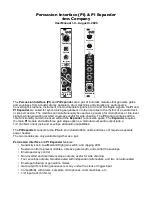
Sidechaining with the PI
The
PI
can be used for sidechaining and
ducking effects. Sidechaining is a technique
where one audio signal triggers an effect on
another audio signal. Ducking is a commonly
used form of sidechaining where the kick
drum of an audio track will cause the other
instruments to suddenly decrease in
loudness, or “duck”.
The following is a basic procedure for
creating a ducking effect:
1. Run an audio source such as an
oscillator or a musical track into the
audio input of a VCA.
2. Patch the
Inv. Out
from the
PI Expander
to the CV input of the VCA.
3. Patch the kick drum signal into the
IN
on
the
PI
or the Input on the
PI Expander
.
4. Flip the switch to
Gen.
mode
.
5. Adjust
Sensitivity
and the
L|M|H
switch
so that the white
Gate
light fires every
time the kick drum is hit. Adjust
Sustain
as low as possible without causing mis-
fires.
6. Listen to the audio being “ducked” as
you adjust
Inv. Level
and
Env. Decay
to
set the amount of effect and “recovery”
speed.
When triggered, the
Inv. Out
signal will jump low, causing the VCA to drop the volume of the audio. As
the inverted envelope decays, it rises back to its resting voltage, and the audio source increases in
volume.
The
Inv. Level
knob controls the amount of decrease in the audio signal’s amplitude. Turning this knob
down might require you to turn the VCA’s offset or gain control up to compensate.
The
Env. Decay
knob controls the “recovery” time (the time it takes for the audio signal to return to
normal after a kick drum).
The
Sustain
knob can also help craft the sound by adding a delay after the kick drum and before the
envelope begins to rise back up to maximum voltage.
Page of
14
16
PERCUSSION
INTERFACE
IN
+
–
Sensitivity
Sustain
Env. Decay
Follow
Gen.
Gate
Env.
Out
Env. Level
Inv. Level
Env. Out
Inv. Out
Audio Out
Input
PI EXPANDER
KICK DRUM
To set the amount of
sidechain e
ff
ect,
adjust
Env. Decay
VCA
AUDIO IN
OSCILLATOR
CV IN
















